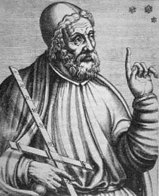

Eudoxus studied with Archytas, a follower of Pythagoras. He learned about geometry, number theory and the theory of music. Eudoxus visited Sicily, where he studied medicine with Philiston, and Athens where he attended lectures on philosophy by Plato.
He then spent over a year in Egypt where he studied astronomy with the priests at Heliopolis. At this time Eudoxus made astronomical observations. From Egypt, Eudoxus travelled to Cyzicus. There he established a School which proved very popular and he had many followers.
He returned to his native Cnidus, and was acclaimed by the people of who put him into an important role in the legislature. However he continued his
scholarly work, writing books and lecturing on theology, astronomy and meteorology.
He had built an observatory on Cnidus and we know that from there he observed the star Canopus. The observations made at his observatory in Cnidus, as
well as those made at the observatory near Heliopolis, formed the basis of two books referred to by Hipparchus.
Eudoxus made important contributions to the theory of proportion, where he made a definition allowing possibly irrational lengths to be compared in a similar way to the method of cross multiplying used today. The theory developed by Eudoxus is set out in Euclid's Elements. Definition 4 in that Book is called the Axiom of Eudoxus and was attributed to him by Archimedes. It is difficult to exaggerate the significance of the theory, for it amounts to a rigorous definition of real number. Number theory was allowed to advance again, after the paralysis imposed on it by the Pythagorean discovery of irrationals.
Another remarkable contribution to mathematics made by Eudoxus was his early work on integration using his method of exhaustion. This work developed
directly out of his work on the theory of proportion since he was now able to compare irrational numbers. It was also based on earlier ideas of approximating the area of a circle by Antiphon where Antiphon took inscribed regular polygons with increasing numbers of sides. Eudoxus was able to make Antiphon's theory into a rigorous one, applying his methods to give rigorous proofs of many theorems, including the volumes of cones and pyramids. Archimedes went on to use Eudoxus's method of exhaustion to prove a remarkable collection of theorems.
We know that Eudoxus studied the classical problem of the duplication of the cube. Eratosthenes, who wrote a history of the problem, says that Eudoxus
solved the problem by means of curved lines.
Perhaps the work for which he is most famous is Eudoxus's planetary theory, which he published in a book which is now lost. Eudoxus may have regarded his system of spheres simply as an abstract geometrical model, but Aristotle took it to be a description of the physical world.
Eudoxus also wrote a book on geography, which, although lost, is fairly well known through
around 100 quotes in various sources. The work consisted of 7 books, and studied the peoples of the Earth known to Eudoxus, in particular examining
their political systems, their history and background. Eudoxus wrote about Egypt and the religion of that country with particular authority and it is clear that
he learnt much about that country in the year he spent there.